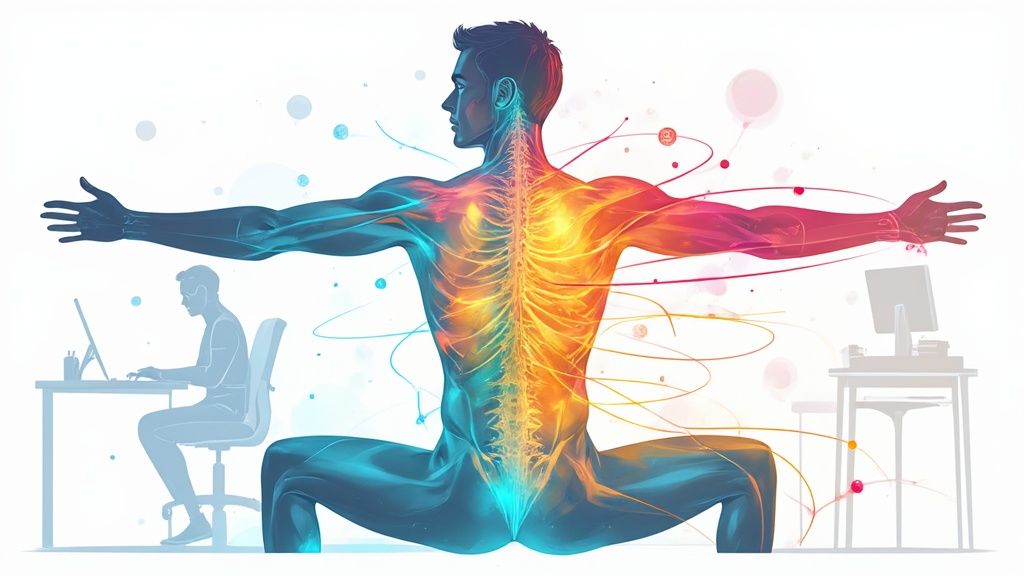10 Best Posture Corrector Exercises: A Science-Based Guide to Perfect Alignment
Understanding Your Body's Posture Story
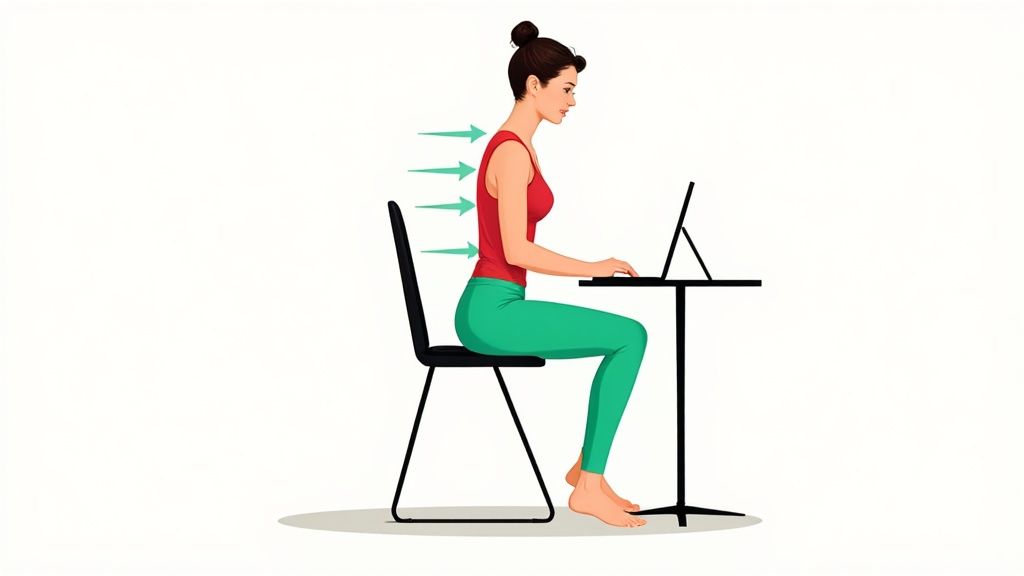
Your daily routine shapes your posture more than you might realize. Whether you spend hours at your computer, looking down at your phone, or behind the wheel, these common habits take a real toll on your body's alignment. Let's explore why these everyday activities affect your posture and set the foundation for understanding how targeted exercises can help.
The Domino Effect of Poor Posture
When it comes to posture, it's not just about standing up straight - it's about how your entire body works together. Poor alignment creates a chain of effects throughout your body's structure. Take forward head posture, a common issue many of us face: even a slight 15-degree forward tilt of your head doubles the strain on your neck and upper back muscles. This misalignment often leads to problems that might seem unrelated at first, like headaches, jaw discomfort, and shoulder pain. That's why fixing your posture plays such a crucial role in your overall physical well-being.
Beyond the Ache: Long-Term Implications
If you ignore posture problems, they can develop into more serious issues over time. Your spine may start to degenerate faster than normal, nerves can become pinched, and your breathing capacity might decrease. The effects go beyond physical discomfort too - research shows that slouching actually impacts your mood and energy levels. This happens because your posture affects your hormone production, which in turn influences how you feel throughout the day.
Posture and Proprioception: The Body's Internal GPS
Your body comes equipped with a built-in positioning system called proprioception that helps you understand where you are in space. This system gets its information from your muscles, joints, and inner ear. But when you consistently maintain poor posture, this natural feedback system starts to malfunction. Think of it like having a faulty GPS - it becomes harder to keep your balance and move efficiently. While posture correctors can help by providing external cues and support, they work best when combined with specific exercises that strengthen the right muscles and retrain your body's natural alignment sensors.
The Path to Postural Improvement
The good news is that you can reverse the negative effects of poor posture through targeted exercise. The right exercises focus on three key areas: strengthening the muscles that maintain good alignment, improving flexibility, and restoring your body's natural awareness of position. By understanding what causes poor posture and committing to regular exercise, you can help your body find its natural balance again, reduce pain, and improve your overall health. In the following sections, we'll show you exactly which exercises can help you achieve better posture and how to do them correctly.
Mastering Core Posture Exercises That Actually Work
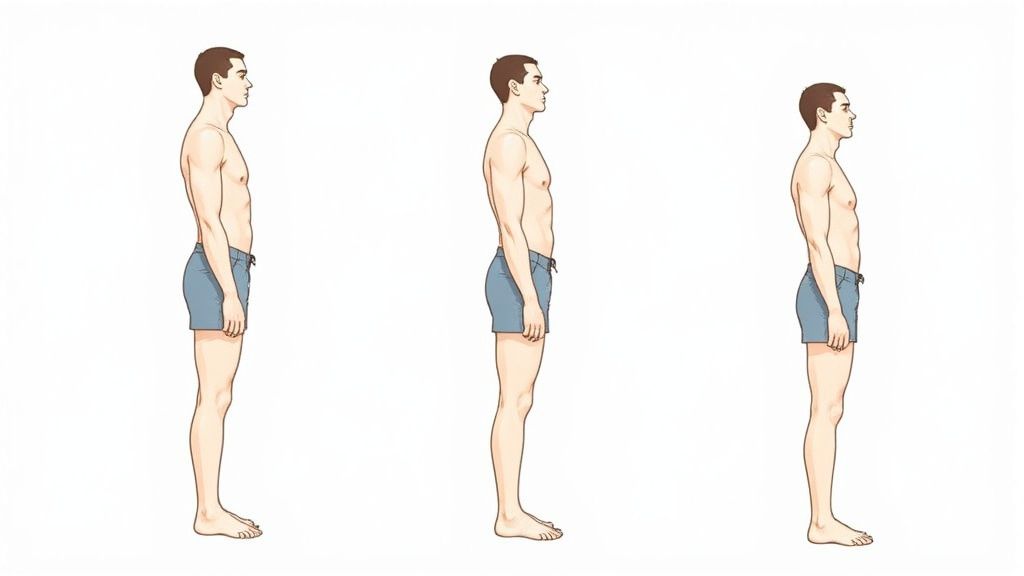
Poor posture takes a toll on your body over time. Let's explore specific exercises that can help retrain your muscles and improve alignment. These exercises focus on key muscle groups that maintain proper posture, so you'll build strength where you need it most.
Targeting Key Muscle Groups for Postural Strength
Good posture relies on several muscle groups working together. The deep neck muscles prevent your head from jutting forward, while the upper back muscles keep your shoulders pulled back in proper alignment. Your spine muscles help you stand tall, and your core provides essential stability.
Here are the main muscle groups to focus on:
Deep Neck Muscles: These muscles at the front of your neck keep your head properly aligned over your shoulders. When weak, they allow your head to drift forward, causing neck strain.
Upper Back Muscles: The muscles between your shoulder blades, including your rhomboids and trapezius, pull your shoulders back into proper position. Strengthening them helps prevent rounded shoulders.
Spine Muscles: Your erector spinae muscles run along your spine and keep you standing straight. When strong, they prevent slouching and maintain good spinal alignment.
Core Muscles: Your abdominal and back muscles work as a unit to support your spine. A strong core gives you the foundation needed for proper posture throughout the day.
Best Posture Corrector Exercises: A Step-by-Step Guide
Try these proven exercises to build postural strength and improve your alignment:
Chin Tucks: This exercise targets the deep neck muscles. Sit or stand straight and gently draw your chin back, creating a slight double chin. Hold for 5 seconds. Think about lengthening the back of your neck upward as you do this movement.
Shoulder Blade Squeezes: Strengthen your upper back by sitting tall and squeezing your shoulder blades together. Picture holding a pencil between them. Hold each squeeze for 5 seconds. This helps combat rounded shoulders from computer use.
Back Extensions: Lie face down with arms overhead. Lift your chest, arms and legs slightly off the floor, engaging your back muscles. Hold briefly, then lower slowly. Keep your core tight throughout the movement to protect your spine.
Plank Hold: Get into a forearm plank position with your body forming a straight line. Hold this position, focusing on keeping your core engaged and back flat. Start with 20-30 seconds and gradually increase your hold time as you get stronger.
Make these exercises part of your daily routine to build the strength needed for better posture. Start with just a few repetitions of each exercise and progress slowly. Be patient - it takes time to retrain postural muscles that have weakened over years of poor alignment. With consistent practice, you'll develop the strength and muscle memory for naturally improved posture.
Creating Your Perfect Stretching Sequence
Now that we've explored essential posture correction exercises, it's time to discuss how to combine them into a personalized stretching routine that works best for you. By crafting a sequence that targets your specific needs, you'll maximize the benefits of each movement and create lasting improvements in your posture.
Designing a Personalized Stretching Routine
Your stretching routine should address your unique postural challenges and daily movement patterns. For example, if you spend most of your day at a desk, focus on stretches that open up your chest and shoulders while also strengthening your back muscles. Consider the positions you hold most often and select stretches that counteract any imbalances. By matching exercises to your specific needs, you'll see better results and feel more motivated to maintain your routine.
Sequencing for Optimal Results: Warm-Up, Stretch, and Strengthen
Start each session with gentle movement to prepare your body. Simple exercises like arm circles or a brief walk will increase blood flow and make your stretches more effective. After warming up, move into stretches that target your problem areas. If you have rounded shoulders, do chest stretches and shoulder blade squeezes. For forward head posture, practice chin tucks and neck rotations. End with strengthening moves like planks and back extensions to build the muscles that support good posture.
Frequency and Timing: When and How Often To Stretch
Finding the right schedule for stretching makes a big difference in your results. While some people benefit from daily practice, others do well with 3-4 sessions per week. Morning stretches can energize you for the day ahead, while evening sessions help release tension from daily activities. Keep in mind that static stretching right before workouts may temporarily reduce muscle power, so save those longer holds for after exercise or separate stretching sessions.
Modifications and Progression: Adapting to Your Body
Since everyone has different flexibility levels and physical needs, it's essential to modify exercises appropriately. If you're new to stretching, start with shorter hold times and gradually increase duration as you become more flexible. Work within your comfortable range and slowly progress to deeper stretches. For any existing injuries or limitations, check with a physical therapist or healthcare provider about safe modifications. They can help you adjust exercises to match your abilities while still making progress toward better posture and mobility.
Building Full-Body Alignment Awareness
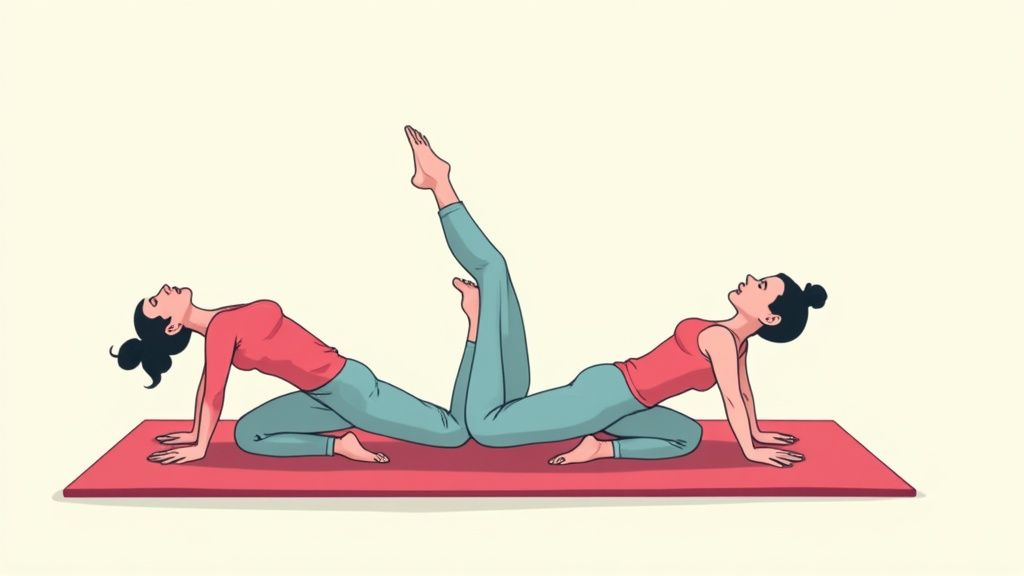
Understanding how your body aligns is essential for good posture. Just like a building needs a solid foundation, your body relies on proper alignment for optimal function. When you learn to notice how different positions affect your body throughout the day, you can make small but meaningful adjustments that prevent problems before they start.
Recognizing Everyday Postural Challenges
Common daily activities often lead to poor posture without us realizing it. Desk work typically causes slouching and rounded shoulders, while looking down at phones strains the neck and upper back. Even carrying a bag on one shoulder can throw your body off balance. These small habits may seem minor, but when repeated day after day, they can lead to real discomfort. That's why learning and practicing good posture exercises is so important for countering these effects.
Developing Body Awareness Through Movement
One simple way to improve posture awareness is through mindful movement. This doesn't require intense exercise - just paying attention to how you carry yourself while walking or sitting can make a real difference. For example, imagining a string gently pulling the top of your head upward can help you find good alignment. Breaking up long periods of sitting with short walks or stretches also helps maintain better posture throughout the day.
Practical Techniques for Daily Activities
Making posture improvements stick requires focusing on your daily routine. Start by checking your workspace - is your screen at eye level? Does your chair support your lower back? Small environmental changes can significantly impact how you hold yourself. Pay attention to early warning signs like stiffness or discomfort, as these signal when your posture needs adjusting. Catching these cues early and doing corrective exercises helps prevent minor aches from becoming bigger problems.
Combining Multiple Approaches for Lasting Change
Getting better posture takes more than one approach. While posture support devices can help temporarily, they work best alongside targeted exercises and increased body awareness. Building strength in key muscles, improving flexibility, and teaching your body proper alignment through regular practice creates lasting changes. Like learning any new skill, developing good posture requires consistent effort over time. This investment in proper alignment contributes to better overall health and comfort in daily life.
Unlocking Natural Movement Patterns
Our bodies were designed for dynamic, fluid motion - not hours of static positions and repetitive movements. Understanding how to integrate more natural movement patterns into daily life is crucial for maintaining healthy posture and preventing pain and dysfunction.
Integrating Mobility Work With Stability Training
Like a well-orchestrated dance, good posture requires both mobility and stability working together. Mobility lets your joints move freely through their full range, while stability gives you control over those movements. Picture a skilled martial artist - they have the fluid mobility to kick and strike, but also the stability and control to maintain perfect balance. Developing both qualities through targeted exercises creates a strong foundation for better posture.
Exploring Movement Patterns and Their Impact on Posture
The way we move throughout the day profoundly affects our posture, for better or worse. Take something simple like sitting hunched over a desk - this restricts upper back mobility and weakens the muscles that keep your shoulders pulled back. Over time, this can lead to rounded shoulders and forward head posture. However, practicing proper form during daily activities, like maintaining a neutral spine while lifting objects, helps distribute forces evenly through the body and prevents strain on any one area.
Progressing From Basic to Dynamic Movements
Just as you wouldn't start running a marathon without training, improving posture requires a step-by-step approach. Begin with simple mobility drills to increase flexibility in tight areas. Then gradually add exercises that challenge your stability, like planks and balance work. For example, once you can hold a basic plank with good form, try lifting one leg at a time to increase the challenge. This builds strength and control while minimizing injury risk.
Adapting Exercises to Your Needs and Lifestyle
Your posture training should reflect your unique life demands and movement patterns. An office worker may need frequent breaks to stretch tight hip flexors, while an athlete requires dynamic exercises mimicking their sport. Even small changes can make a difference - taking the stairs instead of the elevator or standing up every hour to stretch. The key is finding movements you can realistically maintain as part of your daily routine. When natural movement becomes a habit, better posture follows.
Making Perfect Posture Your New Normal
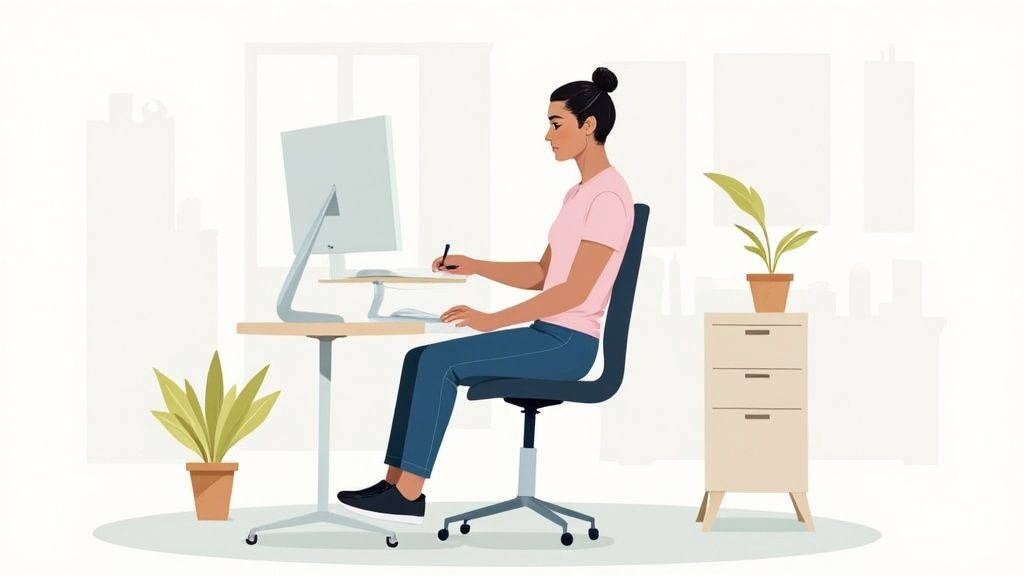
Good posture doesn't happen by accident - it requires consistent practice and mindful awareness throughout your day. Just like brushing your teeth, incorporating posture-improving movements and exercises into your daily routine helps make better alignment a natural habit.
Transforming Your Workspace: Ergonomics and You
Your workspace setup directly impacts your posture and comfort. When your workstation isn't properly configured, your body compensates by adopting awkward positions that can lead to strain and pain over time. The key is creating an ergonomic setup that supports good alignment. For instance, position your monitor at eye level to prevent neck strain, use a chair with proper lumbar support to maintain the natural curve in your lower back, and keep your keyboard and mouse within easy reach. Small adjustments like these can prevent issues like forward head posture, rounded shoulders, and lower back discomfort.
Posture Tools: Allies in Your Alignment Journey
While posture support devices can be helpful tools when starting to improve your alignment, they work best as temporary training aids rather than permanent solutions. Think of them like training wheels on a bike - they provide helpful feedback and support initially but shouldn't be relied on indefinitely. Too much dependence on posture correctors can actually weaken the muscles needed for good posture. Instead, use them strategically while building strength through targeted exercises. As your postural muscles become stronger, gradually reduce your use of support devices.
Building Sustainable Habits: Small Changes, Big Impact
Improving your posture is about making small, consistent changes that add up over time. One effective approach is taking regular movement breaks throughout your day. If you sit for extended periods, set reminders to stand up and do a few posture-correcting exercises every 30-60 minutes. Pay attention to your alignment during everyday activities too - whether carrying groceries, picking up objects, or walking. For example, when lifting something heavy, engage your core and use your legs rather than rounding your back. These little adjustments, practiced regularly, create lasting improvements in your posture and overall wellbeing.
Addressing Challenges and Personalizing Your Approach
Everyone faces different postural challenges based on their daily activities and occupation. A musician, for instance, needs to address strain from holding an instrument, while an office worker focuses on countering prolonged sitting. The key is identifying your specific needs and customizing your posture routine accordingly. This might mean doing targeted stretches for problem areas or modifying exercises to work with your schedule. Listen to your body's signals - if something causes discomfort, adjust your approach or take a break. Creating a personalized plan helps ensure long-term success.
Want to make better posture a natural part of your day? Moova is a mobile app that helps you integrate quick, effective movement breaks into your routine. With over 200 expert-designed exercises targeting posture improvement and common issues like stiffness and low energy, Moova makes it simple to stay active even on busy days. The app delivers personalized 3-minute breaks based on your needs and schedule. Experience the benefits of regular movement with Moova. Download now: https://getmoova.app

